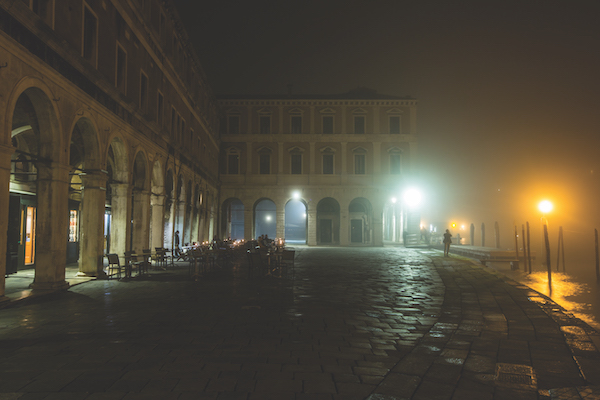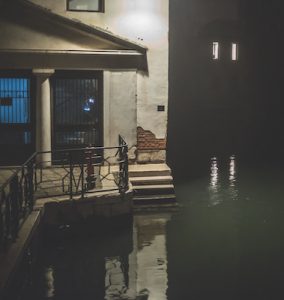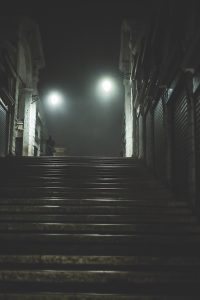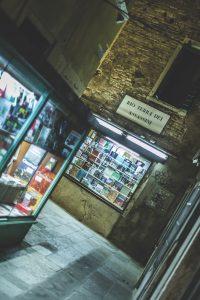Even the most familiar places tend to look a little different as night falls… Sara Scarpa bravely steps into the shadows in search of Venice’s spookiest legends. Photos by Iain Reid
The maze of narrow alleys, combined with the tricks of the light reflected in the canals, the decaying palaces and the fog make Venice the city of mysteries par excellence. The ghosts we will meet here in Rialto and the stories they have to tell are only a few of those you may encounter while walking around at night. There are still many more – from the famous characters of the ancient palaces in the Grand Canal, to the skeleton of Saint Mark’s bell-ringer, to the mad doctor in Poveglia. Each district in Venice has its fair share of ghosts and creepy stories and unnerving legends to be told… I have read so many legends and anecdotes about my home town that sometimes, when I let my imagination run wild, the characters of these stories seem to visit me. They demand to come back to life and be famous once again and it feels almost like I have the duty to keep them alive by telling people their fascinating tales. And so their memory lives on and the story of Venice becomes even more captivating to me. Hundreds of ghosts, legends and stories haunt the floating city…

Murder on Corte del Remer
The sun has long gone, a darkness has descended and the echoing silence is broken only by the lapping of water as it caresses the lips of Venice. The view in front of me is mesmerising: to the left, the profile of the iconic Rialto bridge with its big arcades; to the right, the elegant palaces facing the most beautiful waterway; in front of me, the empty body of the Rialto market and the arcaded Renaissance building by Sansovino, the Fabbriche Nuove.
The white colour from the Istrian stone of the buildings reflects on the gloomy canal, creating a shimmering display. It is late, the campo is deserted and there are no boats on the canal. I close my eyes and I can envision what seems to be a man floating in the canal, holding something. It is difficult to discern as the waterway is very poorly lit, but as he floats closer I can see what it is he is holding: a woman’s head.
On recent occasions when I have found myself in Corte del Remer at night time, this macabre vision has haunted me: the gruesome legend of the beautiful niece of the Doge Marino Grimani, Elena, beheaded at this spot by her jealous husband.
One night, at the end of the 16th century, the Doge happened to be taking a late walk in the area when he heard a woman screaming. On rushing to see what was happening, he quickly realised that the woman in trouble was his niece, and that she was being threatened by her husband, Fosco Loredan. The Doge tried to help her, but he was unable to prevent the murder.
Disgusted by what he had witnessed but also feeling some pity for Loredan, Grimani told him that only the Pope could decide his fate. Loredan went to Rome carrying Elena’s body but was refused an audience. On returning to Venice, broken and desperate, he drowned himself in front of the campo where he had committed his heinous crime.

Marco Polo’s wife
We leave Corte del Remer and go back to the main calle, walking in direction of Rialto. We take the calle on the left, passing the Church of San Grisostomo, to find Corte Prima del Milion followed by Corte Seconda del Milion, with its ancient and beautifully decorated arch. Just before crossing the small bridge, we see the famous Malibran theatre, the richest and most beautiful theatre in Venice in the 17th century and into the first decades of the 18th century – before the construction of the theatre of San Benedetto and, later, La Fenice. Halfway up on its façade is a small plaque commemorating the place where Marco Polo once lived.
Marco Polo was the first European to leave a detailed account of his travels, and his discoveries influenced Christopher Columbus, among many others. It surprises people that there is nothing more here to mark the home of the most famous explorer who ever lived, but Venice has always been against the cult of the individual, whatever their achievements. Marco Polo’s house is not well marked and can be a bit tricky to find, unless you can follow the sweet-sounding song coming from its windows…
According to legend, the ghost of Marco Polo’s wife still wanders in the area singing songs, and sometimes you can hear her mellifluous melodies. During his long travels, Polo spent 17 years in China, where he stayed at the court of the Kublai Khan, the fifth Khagan of the Mongol Empire and the founder of the Yuan dynasty. There he fell in love with and married Kublai Khan’s beautiful daughter.
When after many years, in 1295, he came back home to Venice, he naturally brought his wife with him. Unfortunately, however, the Venetians did not accept the Mongol princess due to her differences in appearance, language and religion (she was indeed non-Christian). Therefore, when Marco was not in Venice she refused to venture out into the streets and stayed in their house alienated from society – her only joys were Marco and singing. When Polo was arrested during the war against Genoa, his sisters, jealous of his beautiful wife, told her
he had been executed. In despair she jumped out of the window and drowned herself in the canal.
We will likely never know if the story is true but recently, during excavations in the foundations of the theatre, the remains of an Asian woman and objects of Chinese origin, including a tiara with the imperial coat of arms, were found in the grounds.

Rialto Bridge and the deal with the devil
Of the 400 bridges in Venice, the Rialto is certainly the most famous and the most iconic. And surprisingly, until 1854, it was the only bridge over the most important artery of the city, the Grand Canal.
For centuries it has been at the very heart of Venice’s trade and commerce. Originally built as a pontoon bridge in 1175, it collapsed on several occasions over the centuries, for a wide range of reasons, and was always rebuilt in wood. The most famous collapse took place in 1444, when the bridge was destroyed by the sheer weight of the crowd admiring the boat parade for the wedding of the daughter of the King of Naples.
Finally, in 1523, it was decided to rebuild the bridge in stone in an attempt to put an end to the frequent collapses that had blighted this important crossing. New bridge designs were put forward by the most important architects of the time, such as Michelangelo, Palladio and Sansovino. However, despite the calibre of the designers working on the project, a commission for construction was not given until 1588, when the task was finally handed to the elderly local architect Antonio Da Ponte; his project was eventually completed in 1591.
There are many legends connected to the stone bridge and its lengthy construction. The most widely known says that every time Da Ponte neared the end of the construction, the bridge would suddenly collapse. The architect, frustrated by his repeated failure, was visited by the Devil, with whom he made a solemn deal whereby he would be able to finish the construction of the bridge in exchange for the first soul to cross it.
Architect Antonio thought he could outsmart the Devil by persuading a cockerel to be the first living creature to cross the bridge. However, he had underestimated the cunning of the Devil, who had already paid a visit to the architect’s house in disguise and convinced his wife that she had to go and visit her husband at the construction site urgently. In order to do this, his wife had to cross the bridge. And so the devil seized her soul.

Rio Terra degli Assassini
This area was well known for the numerous murders that took place here in the past due to the fact that the calle and the bridge were tucked away and particularly dark. It is here that the popular story of a poor baker boy unfolded.
Early one morning in 1507, Piero Fasiol, an apprentice baker from Campo San Paternian, was on his way to see his lover Annella at the house of the Barbo family, where she worked as a servant for Clemenza. When heading down Calle della Mandola and crossing the Ponte degli Assassini (literally the “Bridge of Murderers”), he found the silver sheath of a dagger and, thinking he could use it to raise money to marry Annella, he naively picked it up.
After Annella refused to accept it, unconsciously realising that it was a bad omen, Piero went to put it back where he had found it, but came across the dead body of a noble man who had been stabbed. Covered with blood and with the silver sheath in his hand, Piero was seen by passers-by and accused of the murder. He was tortured and eventually confessed a crime he had never committed.
It was only when the noble Barbo, husband of Clemenza, confessed to the killing of his wife’s lover that the Serenissima realised they had punished the wrong person. The legend says that it is for this reason, in order to remember the poor baker boy, that two lamps on the side of the Basilica di San Marco overlooking the Piazzetta are always lit to this day.
Don’t look now
The recent passing of film director Nicolas Roeg has thrown his 1973 cult thriller Don’t Look Now starring Donald Sutherland and Julie Christie, back into the spotlight. The dark psychological thriller captures Venice in her winter months, and should you embark on taking in some of the film locations at night, be prepared to be looking back over your shoulder – the eeriness in the film is genuine once the sun goes down. Scene locations include Palazzo Grimani, Church of San Stae, Church of San Nicolo dei Mendicoli, Calle de Mezo, Fondamenta dei Felzi and Hotel La Fenice.
Click here for more Venice articles
